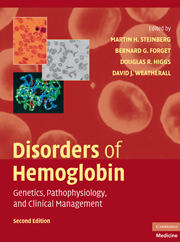Book contents
- Frontmatter
- Contents
- List of Contributors
- Foreword, by H. Franklin Bunn
- Preface
- Introduction, by David J. Weatherall
- SECTION ONE THE MOLECULAR, CELLULAR, AND GENETIC BASIS OF HEMOGLOBIN DISORDERS
- SECTION TWO PATHOPHYSIOLOGY OF HEMOGLOBIN AND ITS DISORDERS
- SECTION THREE α THALASSEMIA
- SECTION FOUR THE β THALASSEMIAS
- SECTION FIVE SICKLE CELL DISEASE
- SECTION SIX OTHER CLINICALLY IMPORTANT DISORDERS OF HEMOGLOBIN
- SECTION SEVEN SPECIAL TOPICS IN HEMOGLOBINOPATHIES
- SECTION EIGHT NEW APPROACHES TO THE TREATMENT OF HEMOGLOBINOPATHIES AND THALASSEMIA
- Index
- Plate section
SECTION THREE - α THALASSEMIA
Published online by Cambridge University Press: 03 May 2010
- Frontmatter
- Contents
- List of Contributors
- Foreword, by H. Franklin Bunn
- Preface
- Introduction, by David J. Weatherall
- SECTION ONE THE MOLECULAR, CELLULAR, AND GENETIC BASIS OF HEMOGLOBIN DISORDERS
- SECTION TWO PATHOPHYSIOLOGY OF HEMOGLOBIN AND ITS DISORDERS
- SECTION THREE α THALASSEMIA
- SECTION FOUR THE β THALASSEMIAS
- SECTION FIVE SICKLE CELL DISEASE
- SECTION SIX OTHER CLINICALLY IMPORTANT DISORDERS OF HEMOGLOBIN
- SECTION SEVEN SPECIAL TOPICS IN HEMOGLOBINOPATHIES
- SECTION EIGHT NEW APPROACHES TO THE TREATMENT OF HEMOGLOBINOPATHIES AND THALASSEMIA
- Index
- Plate section
Summary
At all stages of development, human hemoglobin is made up of two α-like and two β-like globin chains. In embryonic life the ζ and ε genes are fully active, producing embryonic hemoglobin (ζ2 ε2). Between 6 and 8 weeks of gestation there is a switch in expression so that the α- and γ-globin genes become fully expressed, producing fetal hemoglobin (α2γ2). Finally, at around the time of birth there is a further switch from γ- to β-globin expression so that in adult red cells HbA (α2β2) predominates.
In α thalassemia, the synthesis of α-globin chains is downregulated so that in fetal life there is anemia and the excess γ-globin chains form soluble tetramers (γ4) called Hb Bart's. In adult life, α thalassemia also causes anemia but, because by this time the γ to β switch is complete, the excess non–α chains assemble into β4 tetramers, called HbH. The degree of anemia and the amounts of the abnormal hemoglobins (Bart's and H) produced broadly reflect the degree to which α-globin synthesis has been downregulated.
We now know that normal individuals have four α-globin genes, arranged as linked pairs of genes at the tip of each copy of chromosome 16, written in shorthand as αα/αα. α Thalassemia most commonly results from the deletion of one (-α) or both (--) α genes from chromosome 16. Carriers of α thalassemia (-α/αα and --/αα) have mild hypochromic microcytic anemia and may produce detectable amounts of Hb Bart's at birth.
- Type
- Chapter
- Information
- Disorders of HemoglobinGenetics, Pathophysiology, and Clinical Management, pp. 239 - 240Publisher: Cambridge University PressPrint publication year: 2009
- 5
- Cited by



